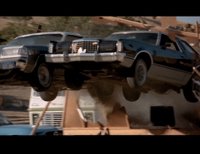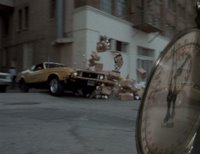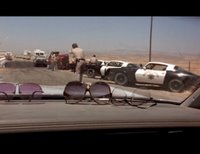The Car Crash King
 Look up any list of cinema’s great car chases, you’ll see a lot of famous face and one oddball choice that appears in list after list. The original GONE IN 60 SECONDS, and its maverick mastermind H.B. “Toby” Halicki stands apart from the slick, Hollywood blockbusters, and not just because his car chase lasts for over 40 minutes. Halicki is a real people’s choice, like Kevin Smith with fender benders instead of sex jokes. Dated beyond repair, his films are most interesting from a historical perspective, and when you take into account the man behind the camera. Halicki’s brief three-and-a-half film career (all recently released on DVD) consists of projects too silly to be taken seriously but too fascinating to be taken any other way.
Look up any list of cinema’s great car chases, you’ll see a lot of famous face and one oddball choice that appears in list after list. The original GONE IN 60 SECONDS, and its maverick mastermind H.B. “Toby” Halicki stands apart from the slick, Hollywood blockbusters, and not just because his car chase lasts for over 40 minutes. Halicki is a real people’s choice, like Kevin Smith with fender benders instead of sex jokes. Dated beyond repair, his films are most interesting from a historical perspective, and when you take into account the man behind the camera. Halicki’s brief three-and-a-half film career (all recently released on DVD) consists of projects too silly to be taken seriously but too fascinating to be taken any other way. Halicki’s unintentional avant-gardism is both a godsend and a challenge for discussion. I have to walk a narrow line between condescension and hyperbole. Cliché labels like “kinetic,” or “pure cinema,” can be avoided by focusing on the human qualities of Halicki’s plotless, characterless, steel-and-chrome opuses. Apart from the handcrafted charm which contrasts the Hollywood thrill-machines (including the Bruckheimered remake of GONE) there really isn’t much there. But does there need to be? Like his trailer for THE JUNKMAN says, “It’s time to put the fun back in the theatre with entertainment for the entire family.” (His PG pictures were high on multiple collisions, and low on blood or swearing.)
Halicki’s unintentional avant-gardism is both a godsend and a challenge for discussion. I have to walk a narrow line between condescension and hyperbole. Cliché labels like “kinetic,” or “pure cinema,” can be avoided by focusing on the human qualities of Halicki’s plotless, characterless, steel-and-chrome opuses. Apart from the handcrafted charm which contrasts the Hollywood thrill-machines (including the Bruckheimered remake of GONE) there really isn’t much there. But does there need to be? Like his trailer for THE JUNKMAN says, “It’s time to put the fun back in the theatre with entertainment for the entire family.” (His PG pictures were high on multiple collisions, and low on blood or swearing.) GONE IN 60 SECONDS is not just the poor cousin to the Hollywood thrillers it competed against and triumphed over (independently financed and distributed, it took in $40 million) nor simply an exploitation flick that got lucky. In car chase landmarks that immediately preceded GONE, the autos were the literal and figurative vehicles for either the megastar (Steve McQueen and BULLITT) or the director (William Friedkin and THE FRENCH CONNECTION). In Halicki’s world, the car is the star. GONE’s opening credits limit the cast list to a single name, “Eleanor,” the 1973 Ford Mustang that a ring of car thieves has to deliver as the final item on their 48-car checklist. Halicki trumpets his amateur status by reserving the cast list for the film’s true leading lady.
GONE IN 60 SECONDS is not just the poor cousin to the Hollywood thrillers it competed against and triumphed over (independently financed and distributed, it took in $40 million) nor simply an exploitation flick that got lucky. In car chase landmarks that immediately preceded GONE, the autos were the literal and figurative vehicles for either the megastar (Steve McQueen and BULLITT) or the director (William Friedkin and THE FRENCH CONNECTION). In Halicki’s world, the car is the star. GONE’s opening credits limit the cast list to a single name, “Eleanor,” the 1973 Ford Mustang that a ring of car thieves has to deliver as the final item on their 48-car checklist. Halicki trumpets his amateur status by reserving the cast list for the film’s true leading lady. Despite his justified bragging rights for personally planning and executing Eleanor’s impressive feats, not to mention his many hats as writer, producer, director, and star—in the role of car thief Maindrian Pace, whose name is his most memorable quality—Halicki balance things with remarkable self-effacement. In the face of the vehicular carnage that is the film’s purpose and his own weak onscreen presence, Halicki intentionally disappears by spending the bulk of his screen time disguised beneath a grey wig and facial hair. Concealed behind their wigs and moustaches (which inspired the Beastie Boys’ “Sabotage” video), the gang is nearly impossible to tell apart.
Despite his justified bragging rights for personally planning and executing Eleanor’s impressive feats, not to mention his many hats as writer, producer, director, and star—in the role of car thief Maindrian Pace, whose name is his most memorable quality—Halicki balance things with remarkable self-effacement. In the face of the vehicular carnage that is the film’s purpose and his own weak onscreen presence, Halicki intentionally disappears by spending the bulk of his screen time disguised beneath a grey wig and facial hair. Concealed behind their wigs and moustaches (which inspired the Beastie Boys’ “Sabotage” video), the gang is nearly impossible to tell apart. This doesn’t mean that Halicki’s films are just car porn, however. To label GONE as all action and no story is to miss its narrative simplicity. Like SPEED, it has no more or less story than is necessary. GONE IN 60 SECONDS avoids repetition, through simple charm. By exquisitely focusing on the car in all its beauty, Halicki avoids many traps that would show his limited filmmaking skills, namely working with actors. He may have removed himself as the focal point of attention, but he inscribes a singular personality on every frame, and his films are a closely tied to his particular vibes, just like Jackie Chan, or Robert Altman. (Tarantino borrowed Halicki's fetish for lining his dashboard with sunglasses for the sheriff in KILL BILL.)
This doesn’t mean that Halicki’s films are just car porn, however. To label GONE as all action and no story is to miss its narrative simplicity. Like SPEED, it has no more or less story than is necessary. GONE IN 60 SECONDS avoids repetition, through simple charm. By exquisitely focusing on the car in all its beauty, Halicki avoids many traps that would show his limited filmmaking skills, namely working with actors. He may have removed himself as the focal point of attention, but he inscribes a singular personality on every frame, and his films are a closely tied to his particular vibes, just like Jackie Chan, or Robert Altman. (Tarantino borrowed Halicki's fetish for lining his dashboard with sunglasses for the sheriff in KILL BILL.)  The personal touch is explicitly underscored in THE JUNKMAN where, under the transparent pseudonym of “Harlan B. Hollis,” Halicki stars as…himself, junkyard operator, director of GONE IN 60 SECONDS, and now owner of a mini-empire. His naïveté removes the taint of the vanity project by once again singing the praise of the amateur. Halicki celebrates his role as a blue-collar craftsman, rather than a purveyor of macho heroics. That Halicki/Hollis is the film’s hero has less to do with egotism than honest literalism: as he is the maker of the film and the driver of the main car. THE JUNKMAN doesn’t hold up as well because Halicki injected some Hollywood conventions, such as broad comedy and overtly sexy girls. (He still stays well within the PG, but there are a lot of long legs, push-up bras and really tight pants.) Their distracting presence shows how foreign such elements were to Halicki’s stripped-down, chop-shop artistry.
The personal touch is explicitly underscored in THE JUNKMAN where, under the transparent pseudonym of “Harlan B. Hollis,” Halicki stars as…himself, junkyard operator, director of GONE IN 60 SECONDS, and now owner of a mini-empire. His naïveté removes the taint of the vanity project by once again singing the praise of the amateur. Halicki celebrates his role as a blue-collar craftsman, rather than a purveyor of macho heroics. That Halicki/Hollis is the film’s hero has less to do with egotism than honest literalism: as he is the maker of the film and the driver of the main car. THE JUNKMAN doesn’t hold up as well because Halicki injected some Hollywood conventions, such as broad comedy and overtly sexy girls. (He still stays well within the PG, but there are a lot of long legs, push-up bras and really tight pants.) Their distracting presence shows how foreign such elements were to Halicki’s stripped-down, chop-shop artistry.Halicki’s next and most perplexing effort, DEADLINE AUTO THEFT, splices footage from THE JUNKMAN and GONE IN 60 SECONDS to create a “new” film. The opening chase, which establishes the enmity between Halicki’s reprised Pace and a police captain played by Hoyt Axton (who later interacts with scenes filmed a decade earlier for GONE), is lifted from the opening of THE JUNKMAN.
 Halicki was obsessed with having the most vehicular damage in a single film. (He holds the Guinness World Record of 150 for THE JUNKMAN, although some sources claim that THE BLUES BROTHERS actually contains more. He also was adamant about doing his own driving stunts. An unplanned accident during GONE nearly killed him and the car. Fortunately, both were okay and 45 minutes later, shooting continued. (The accident became part of the story.)
Halicki was obsessed with having the most vehicular damage in a single film. (He holds the Guinness World Record of 150 for THE JUNKMAN, although some sources claim that THE BLUES BROTHERS actually contains more. He also was adamant about doing his own driving stunts. An unplanned accident during GONE nearly killed him and the car. Fortunately, both were okay and 45 minutes later, shooting continued. (The accident became part of the story.)It all came to end in 1989, when while filming GONE IN 60 SECONDS 2, a water tower that had been rigged to collapse at the end of a chase scene toppled over during preparation. A steel support cable snapped loose and killed Halicki instantly.
 Danny Peary wrote of George Miller’s Mad Max (1979) that it is “less interesting as a story about ‘people’ than as a marriage between a filmmaker’s machines (his camera, his editing tools) and the motor-powered machines that he films.” Halicki pushed that marriage further than anyone.
Danny Peary wrote of George Miller’s Mad Max (1979) that it is “less interesting as a story about ‘people’ than as a marriage between a filmmaker’s machines (his camera, his editing tools) and the motor-powered machines that he films.” Halicki pushed that marriage further than anyone. 



1 Comments:
This comment has been removed by a blog administrator.
Post a Comment
<< Home